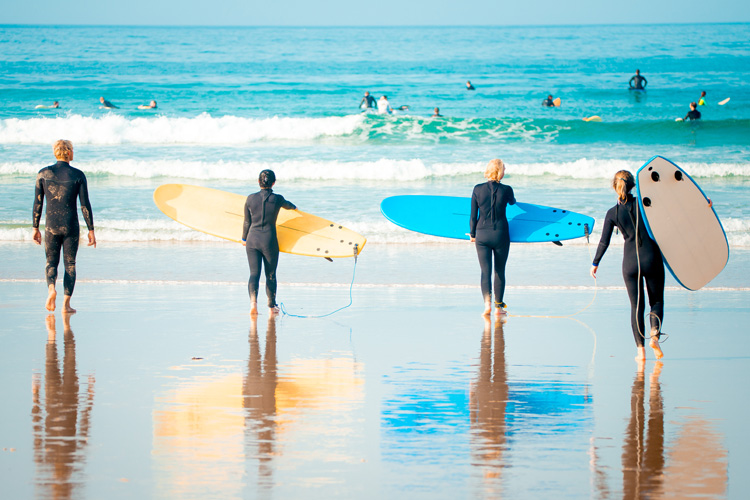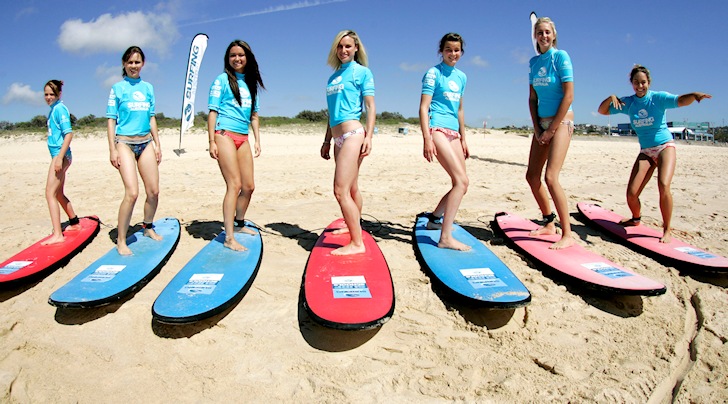Starting a surf school is more than buying ten beginner surfboards and sharing the stoke of surfing. Learn how to set up your signature surf academy by following the official guidelines.
Surf schools are everywhere, and there are almost as many learning centers as teaching methods. Surf schools run the gamut from the good to the not-so-good.
The first things that should be taught to beginners - before pop-ups or paddling - are the basic rules of surf etiquette.
Many experienced and competitive surfers learned how to take off on a wave by themselves.
Surf magazines and surf videos can boost a self-taught newbie's knowledge with time and waves ridden. But schools can be great places to learn, too.
The first surf instruction schools were opened in the 1910s when tourists flocked to Hawaii.
Back in those days, the Waikiki beach boys were the first surfing teachers of the sport.
Modern surf schools started to flourish in California during the crazy 1960s.
Still, the biggest surf academy boom kicked in the early 1990s when surfing dropped its "alternative" image in favor of one promoting a healthy lifestyle.
Today, anyone can run a surf school, surf clinic, or surf camp.
But an important question must be asked: are contemporary surf academies following the necessary requirements, rules, and guidelines for their unique outdoor sports activity?

The Role of the ISA
The International Surfing Association (ISA) - the world governing body for the sport of surfing - has a complete set of requirements that registered surf schools must meet, and many do - but there are always wild cards in the bunch.
This is why it's important to do a little research if you're looking into surf lessons for yourself or someone you know.
National surfing federations should also enforce the ISA guidelines, but some take a more freewheeling approach.
As an unfortunate result, there's a general perception that there are too many surf schools on the beaches, many of which fail to show respect to others out in the water.
If you're interested in starting a surf school, look into ISA's regulations, and do your best to proceed accordingly.
Local surf coaching programs are rare. Australia leads the way with courses recognized by the ISA.
The world governing authority for surfing runs its own schemes and underlines that "an ISA Instructor must be a minimum of 18 years of age to instruct without supervision."
Official Surf School Requirements
So, if you're about to open a surf school or even want to improve your current business, check out the focal points outlined in the official surf school rulebook, as cited by the ISA:
- Surf Schools must have the following equipment: soft-core surfboards with soft fins for beginners, wetsuits, helmets, water-resistant sunscreen, a comprehensive first aid kit, uniformly colored rash vests for participants, area indicators, flags or markers, whistle, rescue board, and mobile phone;
- Surf Schools must have an emergency plan;
- Surf Schools must report accidents;
- Surf Schools must follow a 1:8 coach-to-student ratio;
- Surf School instructors must teach the philosophy of one person per wave;
- Surf School instructors must teach the basic rules of surf etiquette;
- Surf School instructors must never leave a group in the water unattended for any reason;
- Surf School instructors should share the basic techniques of paddling, take-off, trimming, and turning in seven skill requirements and class levels: Never seen a board before (Class 1); Ability to paddle a board in flat water (Class 2); Paddle on to broken waves (Class 3); Ability to ride white water standing (Class 4); Catch an unbroken wave and turn in either direction (Class 5); Ability to perform carving cut-back (Class 6); and Ability to produce carving turns and cope with re-entries (Class 7);
Get the best surfboards for beginners.
